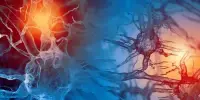If you have migraines or a migraine family history, a headache specialist (neurologist) will most likely diagnose migraines based on your medical history, symptoms, and a physical and neurological examination. Researchers may have discovered a new technique to cure chronic migraines by uncovering a potential new molecular basis for migraines.
The study’s principal author, Amynah Pradhan, is an associate professor of psychiatry at the University of Illinois Chicago. The study’s purpose was to find a new cause of chronic migraine and propose a biological pathway for migraine therapeutics. The study, titled “Neuronal complexity is reduced in preclinical migraine models and recovered by HDAC6 inhibition,” was published in eLife.
Pradhan, whose research focuses on the neurobiology of pain and headache, explained that the dynamic process of routing and rerouting connections among nerve cells, known as neural plasticity, is critical to both the causes and treatments of central nervous system disorders such as depression, chronic pain, and addiction.
The cell’s structure is maintained by its cytoskeleton, which is made up of the protein tubulin. Tubulin is in a constant state of flux, waxing and waning to change the size and structure of the cell. This dynamic feature of the cell permits the nervous system to alter in reaction to its surroundings.
This research suggests that the chronic migraine condition is characterized by reduced neural complexity, and that restoring this complexity could be a feature of anti-migraine therapy. This discovery also lays the groundwork for the development of HDAC6 inhibitors as a potential migraine treatment method.
Amynah Pradhan
Tubulin is altered in the body by a chemical process known as acetylation. Tubulin acetylation maintains a flexible, stable cytoskeleton, whereas tubulin deacetylation, which is caused by histone deacetylase 6, or HDAC6, increases cytoskeletal instability.
According to Pradhan, studies in mouse models indicate that diminished neural complexity may be a hallmark or mechanism of chronic migraine. Tubulin acetylation and cytoskeletal flexibility are recovered when HDAC6 is suppressed. According to the study, HDAC6 also reversed the molecular correlates of migraine and reduced migraine-associated discomfort.
“This research suggests that the chronic migraine condition is characterized by reduced neural complexity, and that restoring this complexity could be a feature of anti-migraine therapy. This discovery also lays the groundwork for the development of HDAC6 inhibitors as a potential migraine treatment method” According to the researchers.

Medications can aid in the prevention of migraines. If you suffer frequent, long-lasting, or severe headaches that do not respond well to treatment, your doctor may advise you to take preventive drugs. According to Pradhan, this study reveals a means to maybe reset the brain to its pre-chronic migraine state.
“Blocking HDAC6 would allow neurons to regain their flexibility, making the brain more sensitive to other sorts of treatment. According to this concept, persistent migraine sufferers may have diminished neural plasticity. If we can restore that complexity, we might be able to break them out of the cycle” She stated.
The brain may become more receptive to pain management medications once it is free of the cycle of reduced neural complexity, according to Pradhan. HDAC6 inhibitors are now being developed for cancer, while HDCA6 has been discovered as a target for other types of pain.
“It raises the idea of something we should look into on a larger basis,” she said. “Are these alterations indicative of all types of chronic pain states?”
Migraines, the third most frequent sickness worldwide, afflict 39 million people in the United States and can be as debilitating as they are common. According to the Migraine Research Foundation, they account for around 1.2 million emergency department visits each year, and more than 90% of sufferers endure severe head pain and neurological symptoms that prevent them from working or functioning. They have also been on the rise as a result of the stress and disturbance caused by the COVID-19 outbreak.
Migraine is a prevalent brain illness that affects approximately 14% of the world’s population. The current yearly cost of migraine in the United States is estimated to be $40 billion. Chronic migraine patients, defined as experiencing more than 15 headache days per month, are a particularly debilitating subset of migraine patients. Migraine treatments are frequently either partially successful or poorly tolerated, necessitating the development of more diversified pharmacological regimens.
















